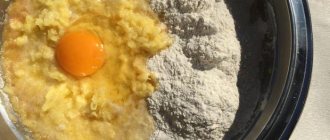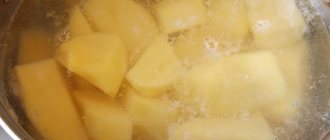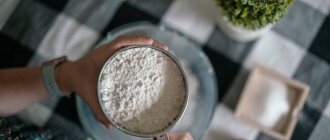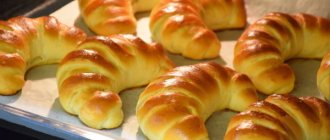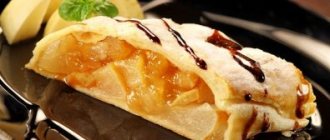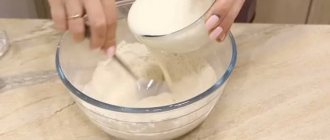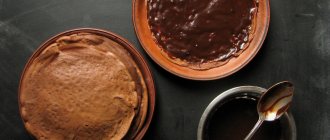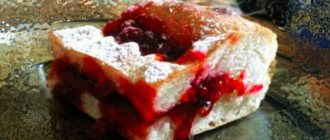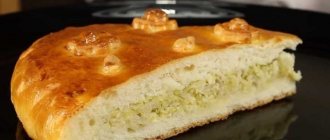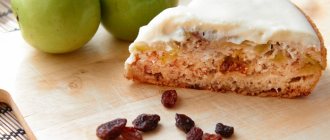How to make choux pastry correctly
To make an excellent sweet or savory dish, it is very important to bake the dough correctly. Not every housewife can boast of successful results the first time, since choux pastry is capricious.
To prepare, you need to get 125 grams of butter, a glass of water and flour, 5 eggs and a pinch of salt. A glass of water is brought to a boil, butter is dissolved there, salt is added, then flour. In this case, it is very important to pour out the flour all at once and mix quickly enough so that there are no lumps. The result is a dough with a thick and dense consistency.
Cooking the dough should last 2 minutes, while the heat on the stove is medium. You need to stir it constantly and quickly so that the dough does not burn and cooks well. For these reasons, the dough is called choux.
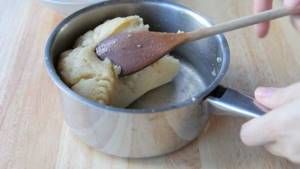
The eggs are added to the dough last, stirring constantly until it begins to stretch. But before that, you need to remove it from the heat and cool slightly, stirring for several minutes with a spoon.
One of the secrets to making choux pastry is to use eggs not from the refrigerator. If they are there, you need to pull them out before starting work and rinse them in warm water.
They will have time to warm up a little before being put into the dough. If the eggs are quite large, you can use not 5, but 4 pieces. In the case when they, on the contrary, are small, it is better to take 6 pieces.
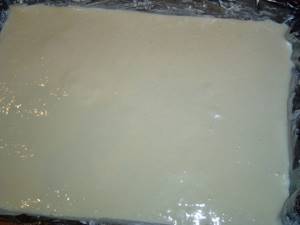
Experienced housewives do not recommend mixing choux pastry with a mixer so that it does not become too liquid. When it starts to stretch when you add the eggs, you have enough eggs.
HOW TO MAKE choux pastry
1. Choux pastry is the lightest, airiest, crispiest dough from which profiteroles, eclairs and choux buns are made. It rises in the oven when the heat does not “bind” it. Airy choux buns are obtained due to the high water content in the dough, which turns into steam in the oven and causes the dough to rise high. One of the advantages of choux pastry is that to prepare it you do not need to know any dough preparation skills, nor lightness of hands, nor the ability to carefully roll out the dough. I never squeeze the choux pastry out of a pastry bag, as the crust of finished profiteroles scooped out with a spoon looks much crispier than those squeezed out of the bag. 2. To make about 30 choux buns, you need 60 g of bread flour (strong plain flour), which contains more gluten (gluten) than regular flour, and the crust is crispier. Since you will need to quickly fold the flour into the water and oil, take a large sheet of parchment (baking paper) and fold it in half to create a crease in the middle. Then unwrap and sift the flour onto the paper and add a teaspoon of sugar (if you are making a sweet choux pastry) or seasonings, salt and pepper. 3. Then pour 150 ml of cold water into the pan and add 50 g of butter, cut into pieces. Then place the pan over medium heat, stirring with a wooden spoon. Once the butter has melted and the mixture comes to a boil, turn off the heat as boiling too long will cause too much liquid to evaporate. 4. Then add the flour - all in one go - pouring in with one hand and quickly whisking with the other. You can do this with a wooden spoon, although an electric mixer will save you a lot of effort. 5. Whisk until the pan forms a smooth ball that releases easily from the sides of the pan - this will take about 1 minute. 6. Beat 2 eggs well and then add to the mixture, pouring in a little at a time and beating after each new portion. 7. Blend until you get a smooth, shiny paste. At this point, lightly oil the baking tray and run under cold water for a few seconds, then tap it to remove any excess moisture. This will create a moist atmosphere in the oven and the steam will help the buns rise. 8. To make choux buns, place a teaspoon of the mixture on a baking sheet, leaving 2.5 cm between each. Bake in the upper part of the oven (on the highest shelf) at 200 degrees C for 10 minutes. After this, increase the temperature to 220 degrees C and bake for another 15-20 minutes until the buns are tall, crispy, airy and golden. 9. Pierce the finished buns on one side to release steam, then cool them on a wire rack. Try these recipes:
> Chocolate profiteroles with praline filling > Churros with fruit dip > Simple puffin cookies > Custard cookies
See also:
> Choux pastry in a food processor
Baking choux pastry
Now you can start heating the oven to 200 degrees Celsius. The baking tray where the products will be baked must be greased. The dough is carefully placed there using a spoon, thus forming buns. For easy work, the spoon must be constantly moistened with water so that the dough sticks well from it.
It is not recommended to make the buns too large, otherwise they will not be able to bake properly. When baking eclairs, you can generally use a teaspoon, since the products become twice as large as their original size. They should stay in the oven for about half an hour.
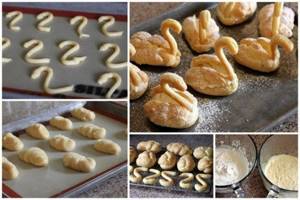
Interestingly, you only need to put the raw dough in an oven heated to 200 degrees, but when the products rise a little and the crust turns golden, the temperature can be lowered to 150 degrees.
If the temperature is reduced too early, the buns may fall and not rise again. But if you don’t do this at all, they won’t bake. It all depends on the size of the products themselves, so medium is the most optimal - baking takes 15 minutes at any temperature.
To determine the readiness of eclairs or profiteroles, one of them must be quickly removed from the oven. If the cold air does not have a negative effect on it, its shape will remain normal, which means that the remaining products can be removed from the oven.
If several batches of desserts are being prepared at the same time, the subsequent batches must be placed on a cold baking sheet, so it will have to be cooled under running cold water. After the baked products have cooled, they must be filled with filling to taste.
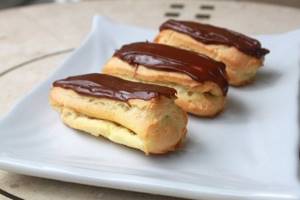
To fill, you need to use a ceramic knife, slightly cutting the dessert. Then you can inject the cream with a culinary syringe. The most popular type of cream is protein. Its preparation consists of beating cold egg whites with sugar until the consistency of stable foam.
Choux pastry
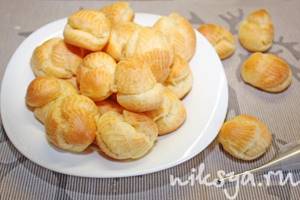
You may be surprised, but there are many variations of choux pastry, at least to me, thanks to Luke, I know 7, with minor variations. No - the components will always be the same, but in different proportions or - excluding one or another ingredient. You choose for yourself which product and what exactly you want to get in the end.
So, the following ingredients and their effect on the finished baked goods:
Water is the basis of calculation for other products.
Milk can either completely or partially replace water. It can also be excluded completely. But choux pastry with the addition of milk will come out more tender, softer and will brown more in the oven.
You can replace butter with margarine, lard, and concentrated fats. But I would not recommend doing this - after all, for such delicate and delicate things as confectionery art, it is better to use natural ingredients - butter. Its presence helps retain steam, and this helps the choux pastry rise beautifully and fluffily while baking in the oven.
The flour should be “weak” - low in gluten. With this flour, the products will come out softer and lighter.
Eggs. Their quantity depends on the amount of other products in your recipe and on the finished product you want to get. Variations are possible when only egg whites are used in the dough.
Salt improves the taste, gives it completeness and allows it to open up fully. The usual amount used is 0.5-1% of the original liquid.
Sugar - its presence is insignificant, but it improves the taste. But it is not as important as the other ingredients - in choux pastry, the most important role influencing the sweetness of the taste is usually played by the filling.
7 choux pastry options:
Choux pastry No. 1: water - 1000 g milk - 0 g butter - 1000 g flour - 1000 g eggs - 2072 g egg whites - 0 salt / sugar - 5 g/5 g
Choux pastry No. 2: water - 1000 g milk - 0 g butter - 750 g flour - 1000 g eggs - 1932 g egg whites - 0 salt/sugar - 5 g/5 g
Choux pastry No. 3: water - 1000 g milk - 0 g butter - 500 g flour - 1000 g eggs - 1888 g egg whites - 0 salt/sugar - 5 g/5 g
Choux pastry No. 4: water - 1000 g milk - 0 g butter - 500 g flour - 600 g eggs - 1100 g egg whites - 0 salt/sugar - 5 g/5 g
Choux pastry No. 5: water - 500 g milk - 500 g butter - 450 g flour - 550 g eggs - 1125 g egg whites - 0 salt/sugar - 5 g/5 g
Choux pastry No. 6: water - 1000 g milk - 0 g butter - 1000 g flour - 500 g eggs - 1008 g egg whites - 280 g salt/sugar - 5 g/5 g
Choux pastry No. 6: water - 1000 g milk - 0 g butter - 1300 g flour - 650 g eggs - 1180 g egg whites - 500 g salt/sugar - 5 g/5 g
If you count the amount of liquid at all times as 1000 g, then the heaviness or lightness of the dough depends on the ratio of fat to flour. The more flour in relation to butter, the thicker the crust of the choux pastry will be, and vice versa, the more butter in relation to flour, the thinner and more elastic the crust will be, and the choux pastry will be empty inside.
The butter must be cold and always cut into pieces. If you put a whole piece of butter in water or milk, it will not have time to dissolve before boiling. If the milk has boiled but the butter has not yet dissolved, remove from the heat and help it disperse in the liquid, constantly stirring with a wooden spatula.
Before adding flour, water or milk and butter should boil well. Add flour all at once and mix well. The dough should have the consistency of custard and when stirred with a wooden spatula, it should form a nice, elastic lump.
Luca Montersino recommends not lining the baking sheet with parchment paper. As the dough heats up and fills with air, it releases from the paper and forms a bulge at the bottom, allowing your choux balls to roll freely around the pan as they bake. Custard cakes should have a flat bottom. Just lightly grease the baking sheet with oil and remove the excess with a napkin. This lubricant will help the custard cakes to better “catch” onto the baking sheet and rise well, and at the same time, you can easily remove them from the surface.
Baking: For the heaviest dough (with a lot of flour, but with little butter) - 180C.
For medium (flour and butter in equal proportions) - 200C.
For light (with a lot of butter, but with little flour) - 220C.
When the choux pastry has grown well in volume and begins to brown slightly, open the oven door to allow excess moisture to escape, then close it again and dry it a little more for the remaining time.
Basic recipe for choux pastry (pasta per il bign? ):
360g whole eggs (about 6 whole eggs) 245g water 221g butter 35g whole milk 235g flour pinch of salt
In the original recipe, the quantity was indicated 3 times more, I reduced it for ease of use. Although, such dough can be stored in the refrigerator for 2 days, you just need to cover it well with film so that it does not dry out. The second option is also very convenient: after baking, you can freeze the finished products, with or without filling, in the freezer.
Bring water and oil to a strong boil. Add all the flour at once. Stir with a wooden spatula until smooth and until the dough begins to pull away from the sides.
Remove it from the heat. There is no need to refrigerate the dough.
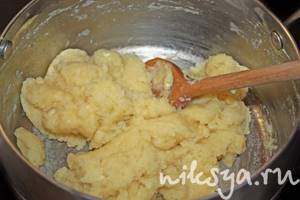
Three options for kneading dough:
1. Mix the dough in a food processor
2. Hand mixer
3. Manually. If this is the only option you have, then add the eggs one at a time, because... The dough is quite hard and if you add a lot of eggs at once, you will not be able to mix it.
In a food processor or hand mixer, use the hook attachment because... The dough should only mix and not absorb air. Turn it on low speed.
Pour in milk and stir. The milk will help the dough cool slightly and reach the right temperature to accept the eggs. You should not immediately add eggs to hot dough; in this case, it will rise worse in the oven.
Add one egg at a time, mixing well each time until you get a homogeneous mass.
Then look at the consistency of the dough, it should be like cream, slightly dripping from the nozzle. It is possible that the liquid has evaporated more than necessary during boiling and you will have to add a little more eggs. In this case, break and mix another egg and add it a teaspoon at a time to the desired consistency.
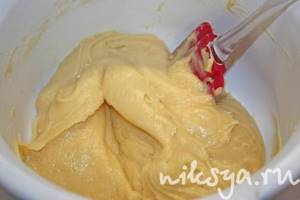
Place the dough on a baking sheet using a pastry bag or syringe - balls, eclairs or drops. You can sprinkle lightly with sugar, powder, almond petals.
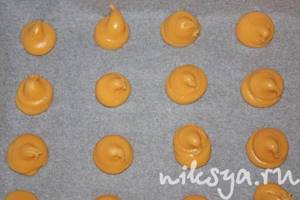
Bake in a preheated oven at 220° for about 10 minutes (depending on the oven and the size of the cakes).
Fill the finished cakes with cream and cover with glaze.
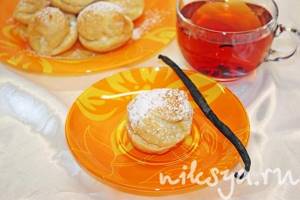
Enjoy your tea!
Rules for serving desserts made from choux pastry
Finished products must be laid out on a plate or tray, making sure to provide them with access to air. This means that the layers should be sparse. You can only leave them covered with paper napkins, as they quickly become damp and soft.
The room where eclairs or profiteroles will be placed must be ventilated. It is important to remember that the refrigerator is not suitable for custards.
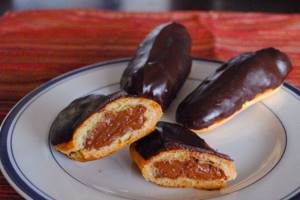
You can make a large number of desserts from choux pastry, which will be appreciated at the highest level by any guest. When preparing it, you must not only strictly follow the recipe, but also adhere to certain rules so that the dough rises well and is baked.
After the choux pastry products have cooled, they are carefully filled with cream, which housewives choose according to their own taste and preference.
